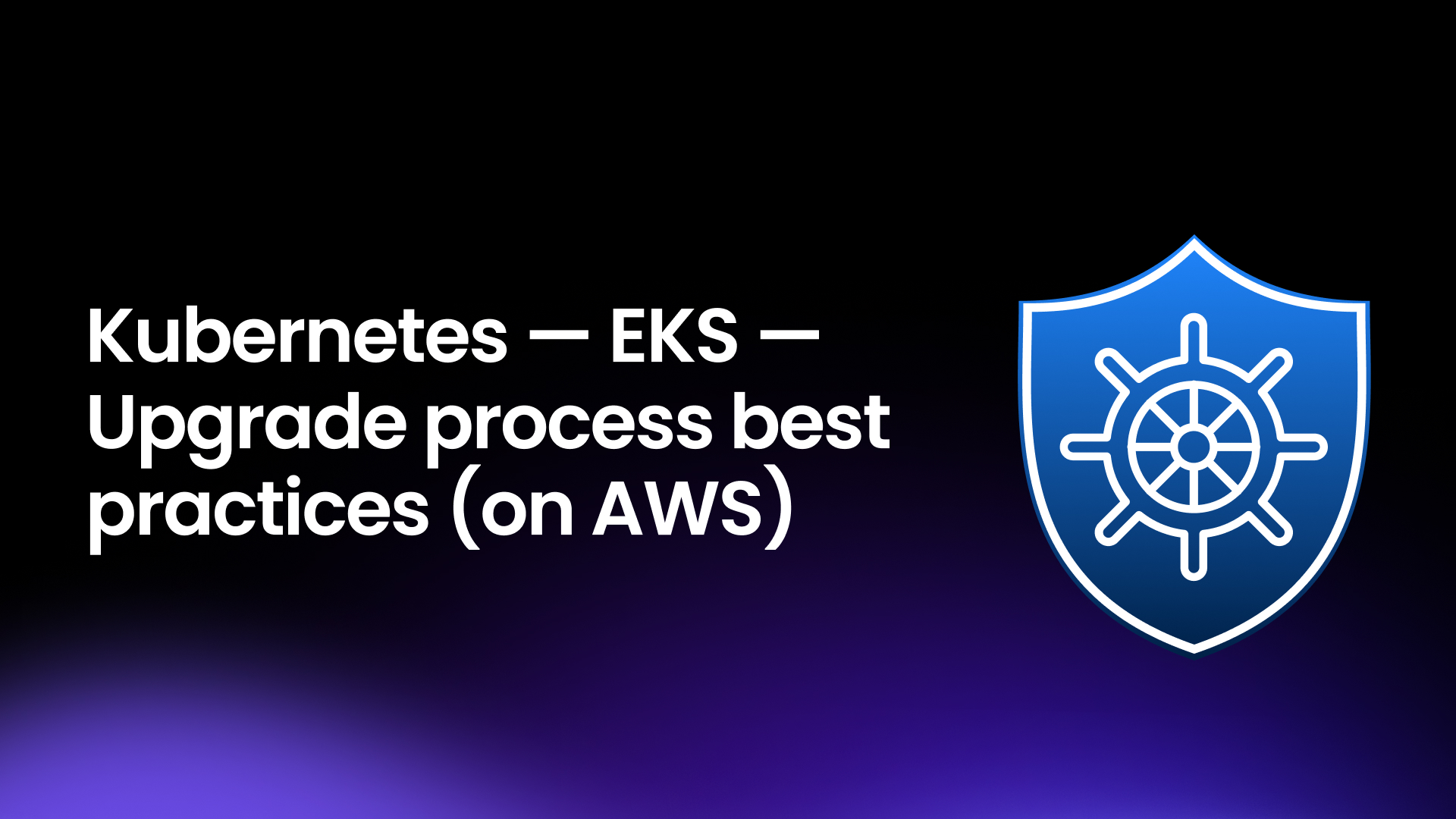Mastering AWS EKS Cluster Upgrades: Best Practices, Prerequisites, and Key Considerations
 Balaji
Balaji
Upgrading an Amazon Elastic Kubernetes Service (EKS) cluster ensures you stay current with Kubernetes features, security patches, and API deprecations. However, the process requires careful planning to prevent service disruptions. This detailed blog will guide you through the prerequisites, key considerations, and best practices to ensure a smooth upgrade.
Key Points to Remember Before Starting
Maximum of 5 Available IPs per Node:
Ensure each node in the cluster has at least 5 available IP addresses in its subnet. A shortage of IPs during the upgrade can cause nodes to fail in joining the cluster.Downgrade Is Not Supported:
Kubernetes upgrades on AWS EKS are irreversible. Once a cluster is upgraded to a new version, you cannot roll back to a previous version.Check Kubernetes Release Notes:
Always review the Kubernetes release notes for deprecations, feature changes, and breaking updates in the target version.Lower Version Upgrades Are Not Possible:
AWS EKS does not allow upgrading to a lower Kubernetes version. If you need a lower version, you must deploy a new cluster and migrate workloads manually.Sequential Upgrades Only:
EKS only supports upgrading one minor version at a time. For example, if your cluster is on version 1.25, you must upgrade to 1.26 before moving to 1.27.
Prerequisites for AWS EKS Cluster Upgrades
1. Check Cluster Version Compatibility
Use the AWS CLI to determine your current Kubernetes version:
aws eks describe-cluster --name <cluster-name> --query cluster.versionConfirm the target version is supported by AWS EKS. Sequential upgrades are mandatory; skipping versions is not allowed.
2. Backup the Cluster
Export all resources and configurations to YAML:
kubectl get all --all-namespaces -o yaml > cluster-backup.yamlUse tools like Velero for automated snapshots, including PVCs and critical data.
3. Validate Subnet IP Availability
Ensure each node’s subnet has at least 5 available IP addresses:
aws ec2 describe-subnets --subnet-ids <subnet-id> --query "Subnets[].AvailableIpAddressCount"
4. Review Application Compatibility
Identify and update deprecated APIs:
kubectl api-resources --verbs=list --namespaced -o name | xargs -n 1 kubectl get --show-kind --ignore-not-foundTest workloads on a staging cluster with the target Kubernetes version.
5. Update Kubernetes Tools
Ensure
kubectl, Helm, and other tools match the target version:curl -LO "https://dl.k8s.io/release/$(curl -L -s https://dl.k8s.io/release/stable.txt)/bin/linux/amd64/kubectl" chmod +x kubectl sudo mv kubectl /usr/local/bin/ kubectl version --client
6. Upgrade Node Groups
Managed Node Groups:
aws eks update-nodegroup-version --cluster-name <cluster-name> --nodegroup-name <nodegroup-name>Self-Managed Nodes:
Update to the latest AMI for your region from EKS Optimized AMIs.
Replace older nodes with updated ones using a rolling update strategy.
7. Check IAM Permissions
Verify that your IAM role includes permissions like:
eks:UpdateClusterVersioneks:UpdateNodegroupVersion
8. Update Critical Add-ons
CoreDNS:
kubectl apply -f https://github.com/coredns/deployment/kubernetes/coredns.yamlkube-proxy:
aws eks update-addon --cluster-name <cluster-name> --addon-name kube-proxyVPC CNI Plugin:
aws eks update-addon --cluster-name <cluster-name> --addon-name vpc-cni
9. Plan for Downtime
- Inform stakeholders and schedule upgrades during off-peak hours. Some workloads may experience brief disruptions.
Steps to Perform the Upgrade
Upgrade the Control Plane
Use the AWS CLI to upgrade the EKS control plane:
aws eks update-cluster-version --name <cluster-name> --kubernetes-version <target-version>
Upgrade Node Groups
Managed Node Groups:
aws eks update-nodegroup-version --cluster-name <cluster-name> --nodegroup-name <nodegroup-name>Self-Managed Nodes: Replace with nodes running the updated AMI.
Validate Post-Upgrade
Confirm the cluster’s health and ensure workloads are functioning as expected:
kubectl get nodes kubectl get pods --all-namespaces
Special Note on Downgrades and Lower Version Upgrades
Downgrades: Kubernetes upgrades on AWS EKS are irreversible. Always test upgrades in a staging environment to avoid issues.
Lower Version Upgrades: If you need to migrate to a lower Kubernetes version, the only option is to create a new EKS cluster with the desired version and migrate workloads manually.
Conclusion
Upgrading an AWS EKS cluster requires meticulous preparation. Ensuring application compatibility, sufficient IP availability, and thorough backup practices are critical to a successful upgrade. Always stay informed about release notes and plan for contingencies to minimize downtime.
Would you like to automate any of these processes? Let me know in the comments!
Subscribe to my newsletter
Read articles from Balaji directly inside your inbox. Subscribe to the newsletter, and don't miss out.
Written by

Balaji
Balaji
👋 Hi there! I'm Balaji S, a passionate technologist with a focus on AWS, Linux, DevOps, and Kubernetes. 💼 As an experienced DevOps engineer, I specialize in designing, implementing, and optimizing cloud infrastructure on AWS. I have a deep understanding of various AWS services like EC2, S3, RDS, Lambda, and more, and I leverage my expertise to architect scalable and secure solutions. 🐧 With a strong background in Linux systems administration, I'm well-versed in managing and troubleshooting Linux-based environments. I enjoy working with open-source technologies and have a knack for maximizing performance and stability in Linux systems. ⚙️ DevOps is my passion, and I thrive in bridging the gap between development and operations teams. I automate processes, streamline CI/CD pipelines, and implement robust monitoring and logging solutions to ensure continuous delivery and high availability of applications. ☸️ Kubernetes is a key part of my toolkit, and I have hands-on experience in deploying and managing containerized applications in Kubernetes clusters. I'm skilled in creating Helm charts, optimizing resource utilization, and implementing effective scaling strategies for microservices architectures. 📝 On Hashnode, I share my insights, best practices, and tutorials on topics related to AWS, Linux, DevOps, and Kubernetes. Join me on my journey as we explore the latest trends and advancements in cloud-native technologies. ✨ Let's connect and dive into the world of AWS, Linux, DevOps, and Kubernetes together!